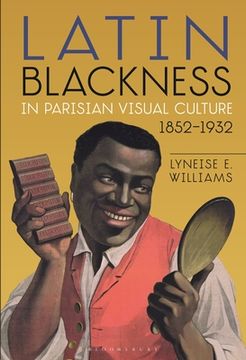Compartir
Latin Blackness in Parisian Visual Culture, 1852-1932 (en Inglés)
Lyneise E. Williams
(Autor)
·
Bloomsbury Visual Arts
· Tapa Blanda
Latin Blackness in Parisian Visual Culture, 1852-1932 (en Inglés) - Williams, Lyneise E.
$ 119.463
$ 238.926
Ahorras: $ 119.463
Elige la lista en la que quieres agregar tu producto o crea una nueva lista
✓ Producto agregado correctamente a la lista de deseos.
Ir a Mis Listas
Origen: Reino Unido
(Costos de importación incluídos en el precio)
Se enviará desde nuestra bodega entre el
Jueves 13 de Junio y el
Miércoles 19 de Junio.
Lo recibirás en cualquier lugar de Colombia entre 1 y 5 días hábiles luego del envío.
Reseña del libro "Latin Blackness in Parisian Visual Culture, 1852-1932 (en Inglés)"
Latin Blackness in Parisian Visual Culture, 1852-1932 examines an understudied visual language used to portray Latin Americans in mid-19th to early 20th-century Parisian popular visual media. It charts how the term "Latinize" was introduced to connect France's early 19th-century endeavors to create Latin America-an expansion of the French empire into the Latin-language speaking Spanish and Portuguese Americas-to its perception of the people who lived there. Elites who traveled to Paris from their newly independent nations in the 1840s were denigrated in visual media, rather than depicted as equals in a developing global economy. Darkened skin, brushed onto images of Latin Americans of European descent, mitigated their ability to claim the privileges of their ancestral heritage; whitened skin, among other codes, imposed on depictions of Black Latin Americans denied their Blackness and rendered them relatively assimilatable compared to colonial Africans, Black people from the Caribbean, and African Americans. In addition to identifying 19th-century Latinizing codes, this book focuses on shifts in latinizing visuality between 1890 and 1933 through three case studies: the depictions of popular Cuban circus entertainer Chocolat; representations of Panamanian World Bantamweight Champion boxer Alfonso Teofilo Brown; and paintings of Black Uruguayans created by Pedro Figari, a Uruguayan artist, during his residence in Paris between 1925 and 1933.
- 0% (0)
- 0% (0)
- 0% (0)
- 0% (0)
- 0% (0)
Todos los libros de nuestro catálogo son Originales.
El libro está escrito en Inglés.
La encuadernación de esta edición es Tapa Blanda.
✓ Producto agregado correctamente al carro, Ir a Pagar.

